Kazaks Revisited
Kazak rugs from the western Transcaucasus have long been a concentrated interest for US specialist collector/scholar Raoul Tschebull, who authored a seminal exhibition catalogue, Kazak, in 1971, and an often-cited article on Kazak design in the third issue of HALI in 1978. In this HALI article he reprises the theme, focusing on three rugs from his collection, with comment extracted from his new book, Qarajeh to Quba:
‘The appellation ‘Kazak’ for a group of coarse long-piled geometric rugs from the western Transcaucasus is in common with a town and district in the Transcaucasus, as well as the Russian ‘Cossack’, ‘Kazakh’, a Turkic tribal group from Central Asia, and ‘Kozak’, a group of geometric rugs from western Turkey. All may derive from Timur’s description of himself as an outlaw or brigand. Because of the variety of structure, Kazak-like rugs that seem older likely came from disparate locations. Some are coarse, long-piled, some are fine, long-piled, and some are intermediate. But by the end of the Caucasian rug boom, Kazak structure was quite standardised. Of the 67 east Azarbayjani and Transcaucasian rugs and flatweaves from my collection that I selected for publication in Qarajeh to Quba, I assigned eight pile rugs and one pile ‘mafrash’ panel to Kazak or the Kazak area (plates 28-36). Three of them, representing well-known ‘types’, are considered in detail below.

(2) ‘Lori Pambak’ Kazak rug, western Transcaucasus, first half 19th century. Warp: Z3S beige wool, warps on one level; weft: two singles, dark red wool, one to three shoots, mostly two; knots: symmetric, V10 x H8 = 80/in2 (c a . 1, 240/dm2), pile height about 10mm; sides: two pairs of reinforced warps interlaced with 5-13 cm segments of wool in all the pile colours; ends: warp finishes missing, outer ‘barber’s pole’ guard borders missing; colours: 9: red, rose, aubergine, butterscotch yellow, green, medium blue, dark blue, ivory, dark brown (partly corroded); 1.73 x 2.18 m (5′ 8″ x 7′ 2″). Author’s collection, published Tschebull, HALI 1/3, 1978, fig.22; Franses et al., Stars of the Caucasus, 2017, fig.10.23; Qarajeh to Quba, 2019, pl.28
‘Lori Pambak’ Kazak (1, 2)
This so called ‘Lori Pambak’ Kazak is relatively finely and loosely woven and would not make a durable floor rug. It is possible it was intended as bedding. Old rugs like this usually have a greyish purple as a secondary colour. Later rugs in this general design are denser and coarser, clearly made for a market that valued floor-worthiness, probably in the west.
The field design is dominated by an ancestral Turkmen ‘gül’ form combined with detached palmettes. The combination seems strange, but the design unit is basically a pendant medallion, and the same theme is applied with different amounts of abstraction to rugs from northern Iran and rural Anatolia. In order to fit this Kazak into a context, it is worth considering that such pendant medallion designs originated with tooled leather Turkish and Persian book covers and were made popular by large Safavid and Ottoman carpets. They appear in village rugs and large workshop carpets all over the Indo-Persian and Turkish weaving areas. The field layout here has fairly close design relatives in western Turkish village rugs, such as an example from the Joseph McMullan Collection (3).
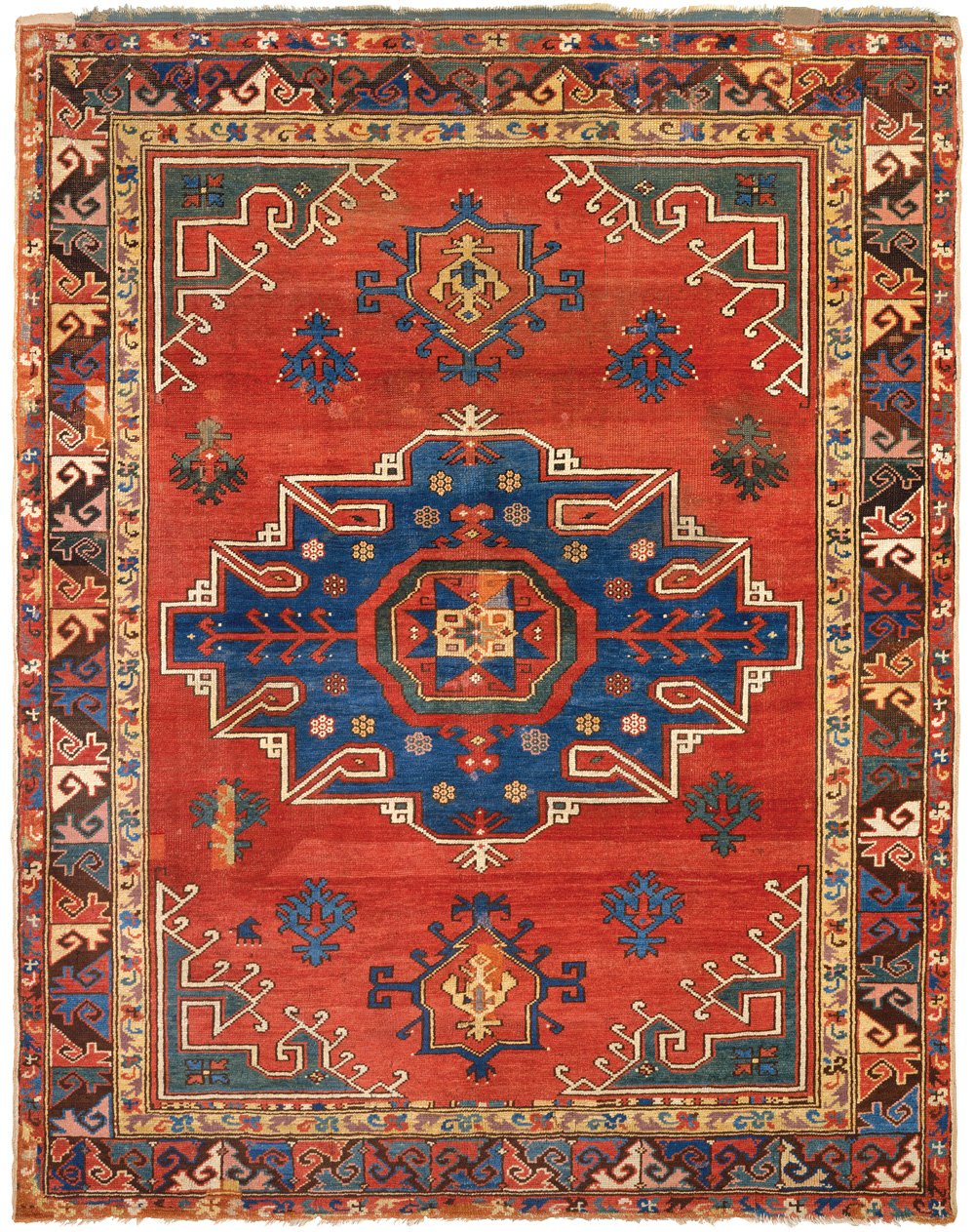
(3) West Anatolian medallion rug, before 1800. 1.59 x 2.08 m (5′ 3″ x 6′ 10″). Metropolitan Museum of Art, New York, Gift of Joseph V. McMullan, 1973, inv.1974.149.33.
Elena Tsareva posits that the pairs of green animal-like forms inside the ivory ‘gul’ are a ‘derivation from the Central Asian steppe kaikalak-type motif … very popular since paleolithic times’. If that is so, they are layered on top of the facsimile of an orthodox-seeming Turkmen gül in this rug, which is quartered, has clear crested dark ‘birds’ on the horizontal axis, and a more stylised pair on the vertical. A presumed local Transcaucasian source for this green design may be found in a fabulous late 17th-century (?) cross-stitch embroidery (4), perhaps Armenian on the basis of the structure, which has the same four pairs of opposed green forms, the whirling dragon centre derived from embroideries, stylised, elaborate crests on the green beasts’ heads, and apparent flames, dragon-like, shooting out of their foreheads, but on a red ground. The stylised dark brown bird forms with crests on the axes in the Kazak rug are serrated white diamonds in the embroidery.

(4) Transcaucasian silk embroidery, 17th/18th century. 0.71 x 1.29 m (2′ 4″ x 4′ 3″). Rippon Boswell, Wiesbaden
Given how similar the medallion motifs are, could the rug and the embroidery be contemporaries? Or could there have been Kazak weaver access to early ‘Lori Pambak’ style embroideries as models? They clearly had local value as they were retained locally in some numbers and have ended up in quantity in western collections and museums. Or is there an intermediate textile that has not been identified? Were the blue and black triangular indents into the red field of the embroidery medallion possibly interpreted by subsequent textile artists—especially Kazak rug weavers— as part of the outline of an archetypal Turkmen gül?
There is another similar Kazak, coarser and with less colour (HALI 85, 1996, p.135), as well as a large fragment from the Rudnick Collection (Grogan, Boston, 20 November 2016, lot 57). A third has the same border as the Rudnick fragment, and another, in an American collection, is quite similar to the present rug. It appears this ‘Lori Pambak’ design suffered loss of its original intent relatively rapidly, especially compared to the stability of other large Kazak rug designs (see Tschebull, ‘The Development of Four Kazak Designs’, HALI 1/3, 1978, pp.257-261).
It would be convenient if design developments were linear. A possible beginning for the progression in the abstraction of the Lori Pambak design is well illustrated in colour by Jean Lefevre (Caucasian Rugs, 1977, no.14); the next stage of design evolution is seen in a ‘commercial’ period rug with palmette-shaped pendants, fused green animals with rudimentary crests in the centre medallion and a version of the earlier leaf/meander main border (Ian Bennett, Caucasian, 1981, no.5). The final stage is illustrated by a rug in which there is a different border, no crests on the green beasts, and octagonal medallions in place of anything resembling a palmette (Bennett 1981, pl.8). These later pieces are often dated, presumably to meet market demand; dates range from the equivalent of about 1895 to 1910. Small Kazaks sometimes have a devolved single Lori Pambak central medallion.
As with many old Transcaucasian rugs, the secondary motifs are of great interest. They virtually disappear in later Lori Pambaks. In this piece, there are three in the field corners, possibly vestiges of spandrels. Generally, the first to go is the ivory ‘bug’-like element (1). In its centre is a ram’s horn-like form that looks similar to the main ornament in ‘Perepedil’ rugs. Could there be a relationship?
Rugs like this have been called ‘Lori Pambak’ for years. Lori is a town in Pambak Province in northern Armenia, and the appellation might or might not be accurate, but it is now firmly attached to this type of Kazak. Present-day Armenia, a Persian khanate before the Treaty of Torkmanchai in 1828, which concluded a war between the Russians and the Persians, was substantially inhabited by Turkic and Kurdish populations before the Russian conquest (see George Bornoutian, Eastern Armenia on the Eve of the Russian Conquest, UCLA Ph.D. thesis, 1976). It is possible that this piece, which, if it is from the Lori area, may date to before the Russian takeover, was woven by Turkic villagers or transhumants, perhaps on a ground loom, as speculated by Lefevre (1977, p.48). A seductive idea.
Regarding geographic origin, in 1973 Ralph Yohe, a distinguished collector and an ardent seeker of anthropological information, photographed relatively late Lori Pambak rugs through a window in a mosque in Kars, eastern Turkey. Mosque-donated rugs are often locally woven, so this design may have originated in the Kars region.
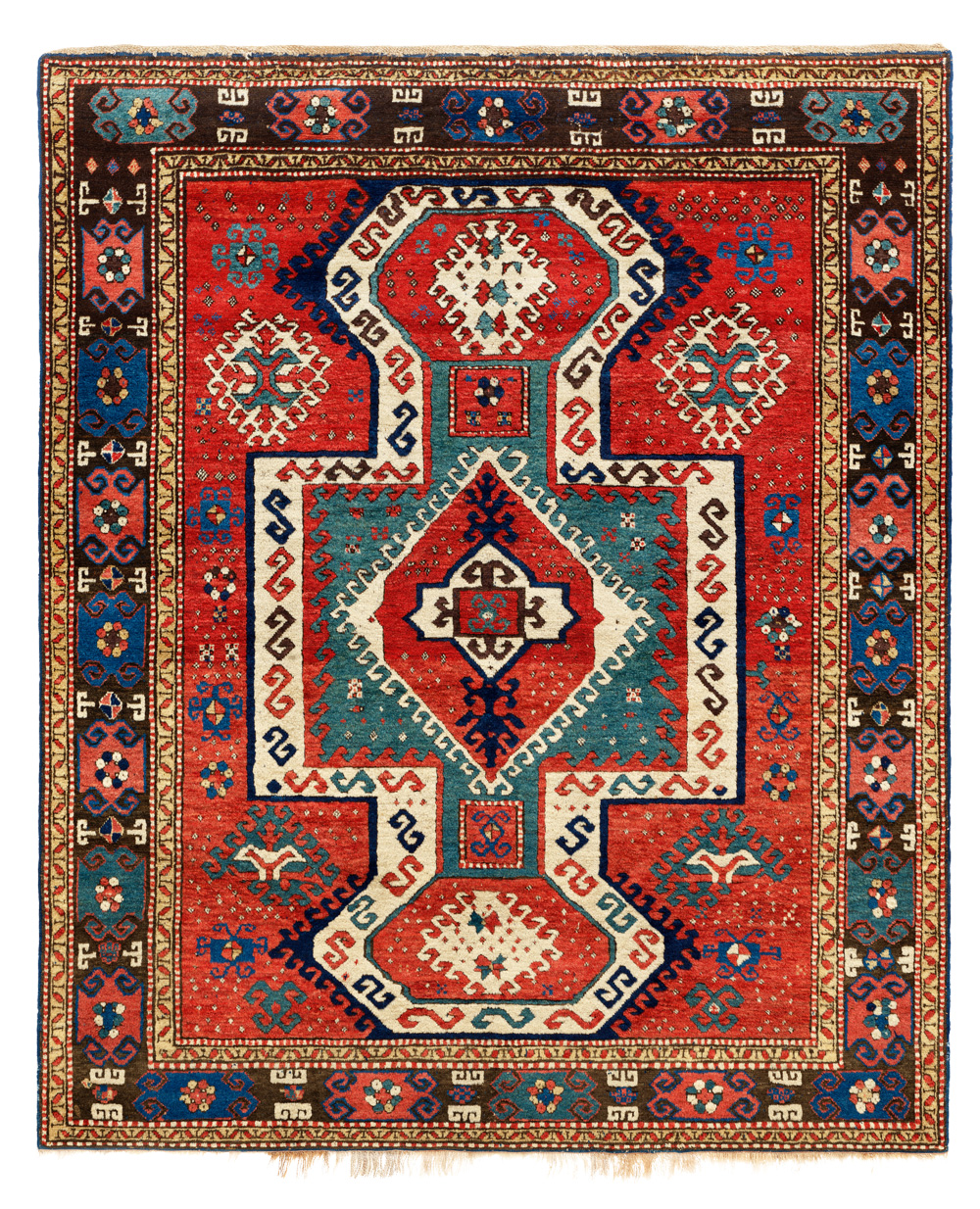
(5) ‘Sevan’ Kazak rug, western Transcaucasus, mid 19th century. Warp: Z2S beige and brown interplied wool, warps on one level; weft: two singles, medium blue wool, two to four shoots, mostly two; knots: symmetric, V8 x H8, = 64/in2 (ca. 992/ dm2; pile height about 12 mm; sides: two pairs of reinforced warps interlaced with medium blue wool, small amounts of ivory wool, where the blue dye did not take; ends: top – 1.5 cm medium blue wool plainweave, following a two-pick obliquely interlaced band. bottom—slightly reduced, 1 cm medium blue wool plainweave terminating in original warp loops, some abraded away; colours: 9: red, ivory, dark brown, green, medium blue, dark blue, salmon, yellow, aubergine; 1.68 x 1.98 m (5’ 6” x 6’ 6”). Author’s collection, published Qarajeh to Quba, 2019, pl.30
‘Sevan’ Kazak rug (5)
Some older Kazaks such as this ‘Sevan’ rug tend to be less dense, in many cases more finely knotted, have longer pile, more colours, especially (three) red tones, and are precise in their own way, yet less ‘mechanical’. The change to shorter pile, denser, coarser knotting and fewer colours was probably a result of commercial pressure later in the 19th century.
This rug is a member of a fairly large cluster, probably from a village—or several nearby villages— in the western Transcaucasus that are remarkably similar in format and layout, as well as in the frequent use of blue wool for wefts and selvedges. It seems the design remained stable in the 19th century although some relatively late pieces have different border conventions (see Tschebull, Kazak, 1971, pl.29; Bennett 1981, pl.16; and several others in private collections and dealers’ inventories). Use of synthetic dyes is quite limited, but some Ponceau 2R is occasionally seen (McMullan, Islamic Carpets, 1965, pl.49; Tschebull 1971, pl.30). One example in this cluster is so close to the present rug that they may have been woven by the same women (Harold Keshishian, The Treasure of the Caucasus, 1992, pl.4), and another is very similar (Eberhart Herrmann, Seltene Orientteppiche VII, 1985, pl. 28). The three madder dye colours are the same, as are the guard borders, and the way the ivory brackets are reversed in the horizontal main borders between the kochanak forms. Another rug with the reversed brackets and the same guard borders has a clear in-woven date of 1271/1854-55 (Herrmann, Asiatische Teppich-und Textilkunst 4, 1992, pl.38). Herrmann (1985) also cites an unattributed prayer rug with an in-woven date of 1283/1866. It might therefore be reasonable to think that this Kazak was woven in that time frame. Many other indicators point to this period as being one in which the output was beginning to grow but the quality remained high (see Tschebull, ‘Methods of dating Caucasian village and nomad rugs’, HALI 2/3, 1979, pp. 218-221).
It is intriguing to contemplate where rug and carpet designs originate, and it is probably a major motivator for collectors and academic interest in the field. Regarding the origin of Kazak designs, there are several large-format field designs whose origin can be traced back to much earlier counterparts in Anatolia, and it begs the question of how some but not all came to be woven in the Caucasus. The answer lies partly in common ethnicity, population movements and trade flows.
Walter Denny thinks that these Kazaks are symmetrical village renderings of the ‘Bellini’ design, and thus probably ultimately derive from a gateway representation, and that they are ‘an interesting example of weavers using age-old traditional motifs in a (comparatively) new layout’. This seems a reasonable interpretation by someone who has had long experience in the field. He posits that this evolved Caucasian ‘gateway’ motif has its predecessors in, for example, four of the rugs that were gathered from the great mosque in Divriği by Walter and Charlie Ellis in the early 1970s (Balpinar & Hirsch, Carpets of the Vakıflar Museum Istanbul, 1998, pls.18-21). He thinks that the rugs were woven in east and central Anatolia, an area with a large Armenian population at one time, and that some of the larger rugs from Divriği may have come from Armenian churches.
Are these particular ‘gateway’ Anatolian rugs of Armenian origin? Hard to say. The Divriği rugs are all a bit different, one from the other, more complex than the Kazak version, but they tend to have red fields, the medallion form in red and green, yellow guard borders, and the main border with a dark brown background, very much like the Kazak example. The Anatolian rugs all have triangular spandrels within the square green central portion of the medallion, as well as in the red field, where they bracket the bulbous ends of the central medallion. Some Kazaks in this cluster have spandrels, but out of proportion with the field, or vestigial spandrels in the medallion in the form of stars and hooked diamonds.
It is a puzzle why the more varied and complex Anatolian versions of this design did not make it into the Caucasus, assuming that, as a result of trade or migration, the design movement went west to east. There is apparently no early Caucasian version of this design that could be cited as a local source. There is no simple resolution to these issues. The simplified, stripped down Kazak version of this design, on the basis of dated examples, does not appear to predate the 19th century.
This rug is in unworn condition, which is unusual. The background of part of the upper main border may be undyed dark brown wool, as it is uncorroded. It is quite evenly knotted, which seems to be characteristic of this group, but an anomaly for Kazaks in general. The implications are unclear.
These rugs are generally known under the rubric ‘Sevan’ for a large lake in northern Armenia, and it may indicate where they were woven. But there is no hard evidence to legitimise the name.
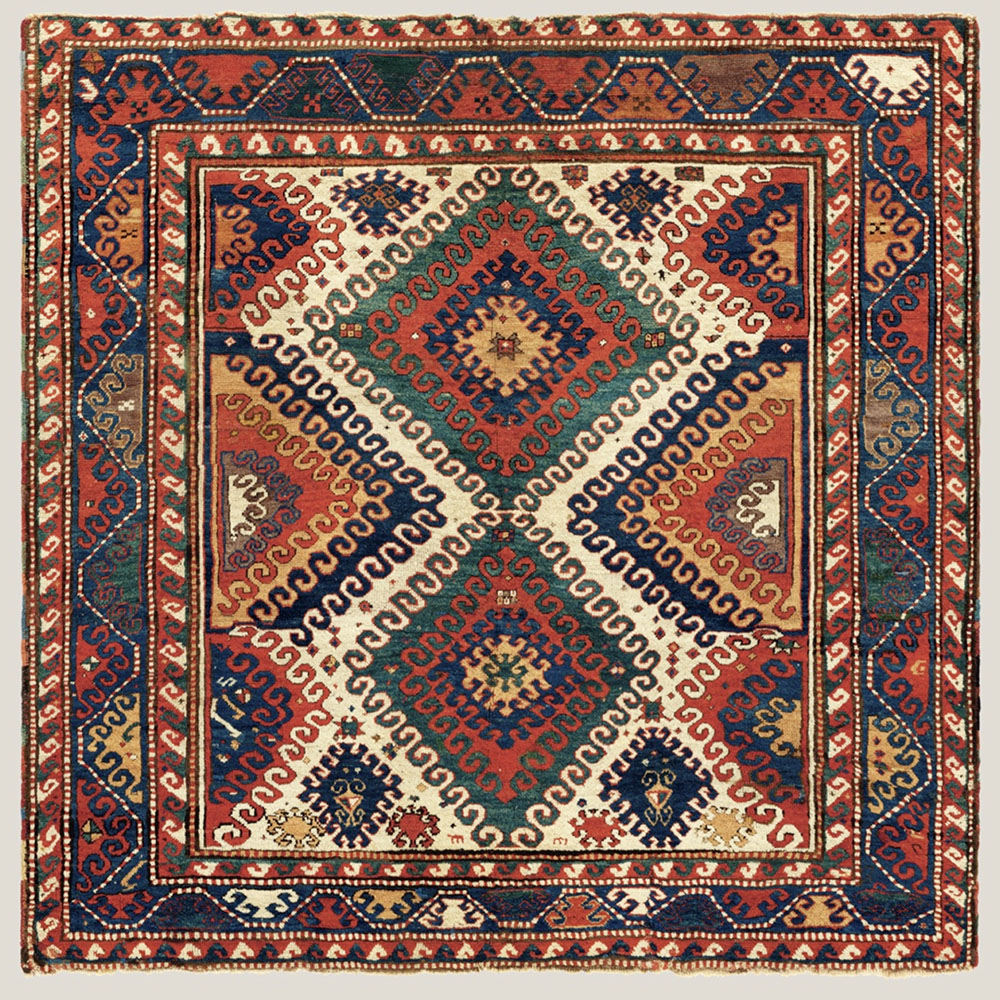
(6) ‘Borjalu’ Kazak rug, western Transcaucasus, 19th century. Warp: Z3S uniform ivory/beige wool; weft: two singles, dark red wool, two to eight shoots, mostly three to four; knots: symmetric, V6-8.5 x H6-7 = average 47/in2 (ca. 735/dm2), pile height about 12 mm; sides: two pairs of reinforced warps interlaced with 3-15 cm sections of multicoloured wool; ends: warp finishes missing; top barber’s pole border missing, remnants of rose wool plainweave at the bottom; colours: 8: red, ivory, medium blue, blue green, abrashed beige/ gold/butterscotch, dark blue, aubergine (partly corroded), dark brown (corroded); 196 x 201 m (6’ 5” x 6’ 7”). Author’s collection, published Tschebull, Kazak, 1971, pl.23 (b/w only); Qarajeh to Quba, 2019, pl.32
‘Borjalu’ Kazak rug (6)
The square format of this ‘Borjalu’ Kazak rug gives the impression that it may have been used as bedding—similar to Anatolian yatak-like weavings—or was based on that model. Coarse long piled rugs like this one are known to have been sheared for floor use by dealers in the west. Did this have much longer pile, typical of bedding rugs, at one point?
The ‘Borjalu’ and a very long Azarbayjani kennereh in my collection (7) come from the same design school. Both have nominal ivory fields, but the Kazak seems further removed from the Turkmen-style model. Designs made up of reciprocal hooked forms occur on diverse objects: Central Asian reed screens, Lakai embroideries and appliqué work, Uzbek mosaic felts, Turkmen rugs, pile-woven transport bags from Fars, kilims, and, of course, numerous flatwoven bags from Azarbayjan and the Transcaucasus.
The basic hooked diamond-shaped medallion probably has its origins in early Oghuz tribal art, but it is tempting to think this particular Kazak field design originated in pieced mosaic/appliqué felts or broadcloth appliqué. The visual similarities between this rug and these other two media are the curved hooks and the lack of ‘background versus foreground’. But despite the prevalence of a felt culture in this part of the world, a longterm search has not turned up any ‘smoking gun’ lookalike Kazak felts. However, a ‘Kazak’ appliqué felted broadcloth horse cover in the Rudnick Collection (Grogan, 20 November 2016, lot 83) as well as a fragment once in a Berlin dealer’s inventory both exhibit patterns found in certain Kazak rugs; while a similar red broadcloth appliqué textile was once in the market. There are surely more. They all hint at a broader decorative appliqué broadcloth/mosaic felt component of the local material culture.

(7) Azarbayjani long rug, kennereh (field detail), northwest Persia, possibly Heriz, 19th century. Author’s collection, published Qarajeh to Quba, 2019, pl.14
A possible, reasonably direct Kazak design source are sumakh bedding bag panels decorated with a repeat hooked diamond design on ivory. These have closely placed multicoloured diamond-shaped hooked forms that look remarkably like the ones in this Kazak, down to the layering of motifs and the accompanying minor hooked elements. They are rare. The style is more commonly found on pieces such as (7), which was woven by a group of Azarbayjani nomads who are thought to have summered in the Bozgush Mountains below Sarab in Iran. It is interesting that what look like riders suspended above four-legged horned beasts on the bag also appear on a Kaitag embroidery from Daghestan in the Ingham Collection, which was exhibited at ACOR in Seattle in 2004. Did the Azarbayjani nomads who wove these hooked diamond bags migrate south from the western Transcaucasus ahead of the Russian incursion? And were they originally seasonal neighbours of Kazak village weavers? Anthropologists have found evidence of general southward migration.
Although settled people would have had little use for most types of transport bags, especially those woven in the sumakh technique, there are other instances in which sumakh designs used by nomads were borrowed fairly faithfully by settled rug weavers, and the other way around—so this particular idea of design transfer is reasonable. It would be nice if there were detailed relevant field data and impressions compiled by a folklorist.
It is curious that the field design, with the pattern made up entirely of hooked forms, seems to have been heavily used for pile rugs in one general western Transcaucasian location. A few other examples have almost the exact same field layout—and format in one case—and have the same type of multicoloured selvedge and especially the particular way of drawing the half medallions in the side borders, with the bottom hook curled toward the guard border (Sotheby’s, New York, 31 January 2014, lot 47; Herrmann, Kaukasische Teppichkunst im 19. Jahrhundert, 1993, pl.53; Bennett 1981, pl.39). The implication is that they were likely woven in the same place at about the same time.
The colours in this rug are strong and there is a good aubergine, which probably gives a rough date of production – before the rug boom really got underway. There are a few knots tied around a single warp. The ivory and butterscotch pile is corroded, which makes the dark blue stand out. ‘Borjalu’ is probably a tribal name and is used elsewhere in western Iran.’
Qarajeh to Quba: Rugs and Flatweaves from East Azarbayjan and the Transcaucasus by Raoul E. Tschebull, with photography by Don Tuttle, is published by HPL and the Near Eastern Art Research Center (2019). Hardbound, 256 pages, 67 colour plates and numerous details and supporting images. It is available to purchase from shop.hali.com


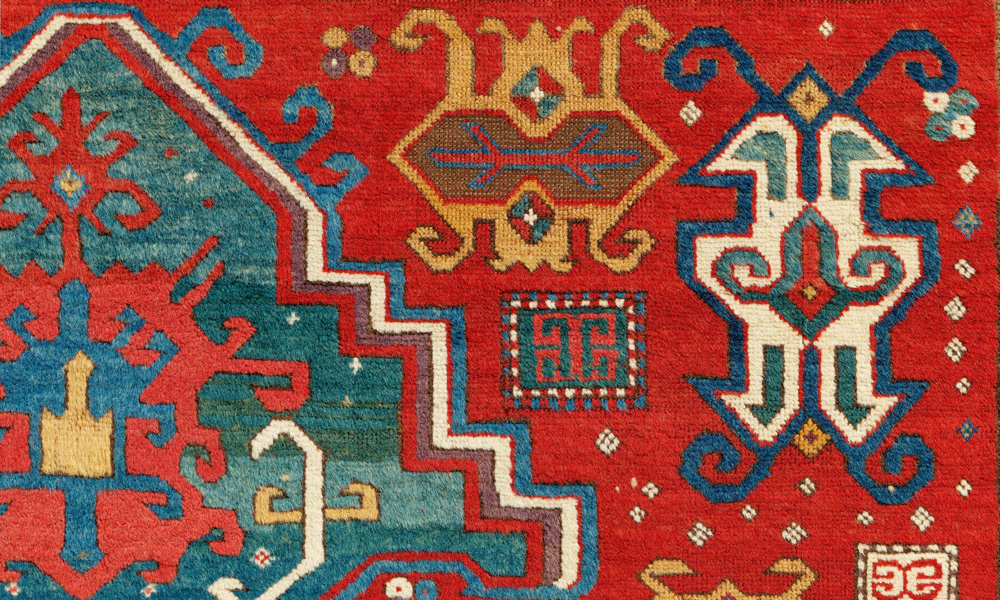
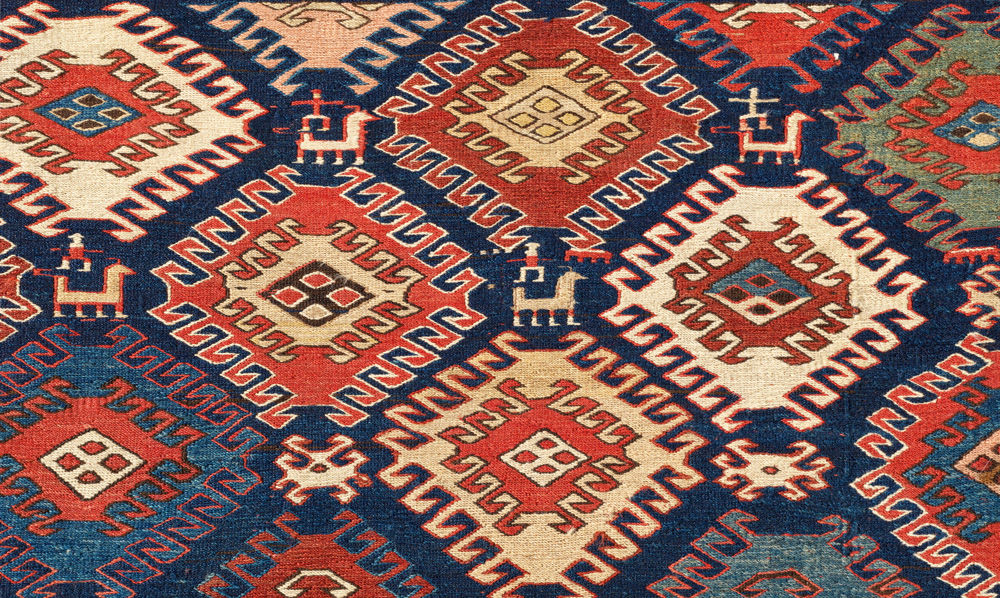













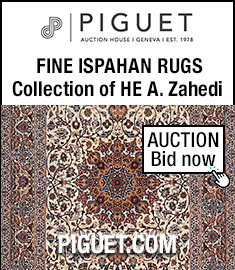
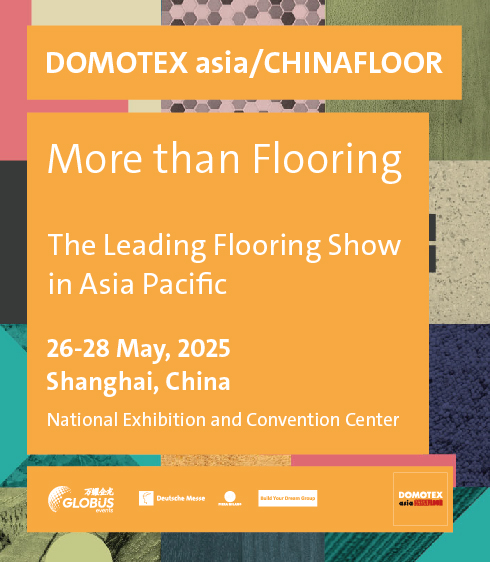






Comments [0] Sign in to comment